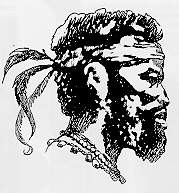Esteban
What does the story of Esteban tell us about African contributions to the settling and founding of the Americas? From Esteban’s account we can began to assemble a picture of how he lived his life. Esteban was an African male who explored the region from Florida to Mexico and reportably had the ability to heal. Though little is told of how Esteban came to accompany the Spaniards, we know that he was initially enslaved. We also know that those who accompanied earlier explorers in the capacity of armed assistants and later armed auxiliaries were more likely than not to gain their freedom. In the case of Esteban, after escaping from his Indian captors, he was free to do as he pleased and he chose to join Cabeza de Vaca on further exploits into the Southwest, including Arizona and Texas.

Estaban: Explorer and Survivor.
The many years in captivity among various indigenous groups also afforded Esteban the “opportunity” to learn many Indian languages, languages which would later enable him to guide missionaries throughout the territory. His ability to understand Indian languages made him a logical candidate for facilitating diplomatic relations between Spaniards and indigenous nations. His familiarity with Indian ways also informed his personal relationships with Indian women. Due to the lack of women of African descent—of the African peoples sent from Seville to the Americas approximately 60% were males—indigenous women were the reasonable choice of mates for Esteban especially during the earlier expedition periods. Readers could also infer that through a combination of learned African, Spanish and Indian traditions, Esteban knew how to cure certain illnesses which plagued many people in the region at the time. Esteban’s ability to cure illnesses, communicate with various indigenous groups, and act as a translator and guide for missionaries illustrate how he and others like him acculturated to both Indian and Spanish ways (Flores 2004; Taylor 1998).





